For the latest updates and improvements in production, open docs.codacy.com instead.
Using coding standards#
Coding standards enable the analysis of multiple repositories with the same tool and code pattern configurations, ensuring consistent code quality across your organization. For example, you can use a coding standard to ensure that a group of repositories follows the same security rules or coding conventions.
This page covers the following topics:
- Creating a coding standard
- Configuring a coding standard using advanced settings
- Defining a default coding standard
- Editing a coding standard
- Deleting a coding standard
- Using a coding standard alongside tool configuration files
Creating a coding standard#
Note
Codacy currently supports up to 10 coding standards per organization.
To create a coding standard for your organization:
-
Open your organization Policies page, tab Coding standards.
-
Click the button Create new standard at the top right-hand corner of the page. This opens the coding standard creation form.
-
Enter a unique name for the new coding standard.
Optionally, you can:
- Select a repository to use as a baseline for the new coding standard. This is useful if you already have a well-configured repository that you wish to use as a template.
- Set the new coding standard as your organization's default, so it applies automatically to new repositories.
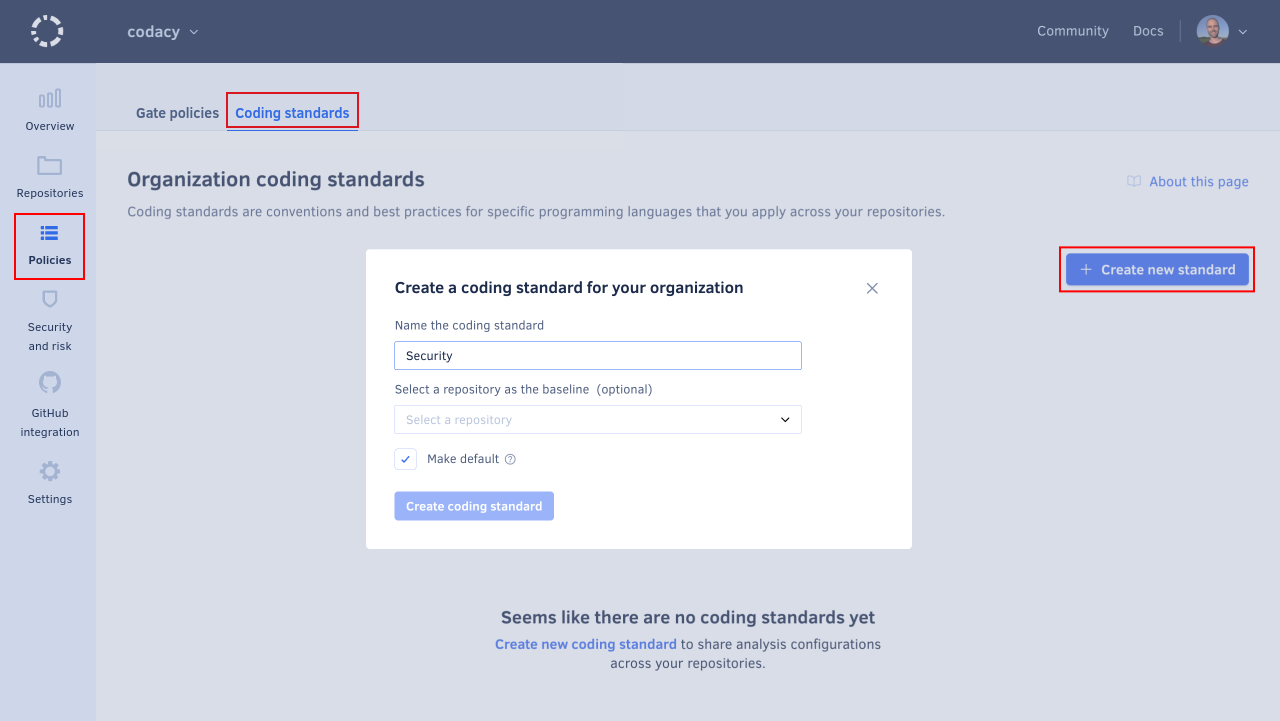
-
Click Create coding standard.
-
Adjust the sensitivity of the coding standard from Essential to Comprehensive for each issue category group:
- Essential: Focuses on the most important issues by including the most critical code patterns. Ideal for initial integration, to prevent overwhelming developers, and to speed up analysis times.
- Comprehensive: Detects all issues by including all code patterns, capturing the complete severity spectrum. Ideal for detailed code quality reviews, while reducing emphasis on critical issues. It may increase analysis times.
Tip
Initially, set the sensitivity to Essential for most category groups to focus on critical code patterns. It helps streamline the integration process with Codacy without overwhelming developers with too many reported issues. You can gradually include more patterns as needed.
If you want more control over included code patterns, click Advanced settings to customize the coding standard.
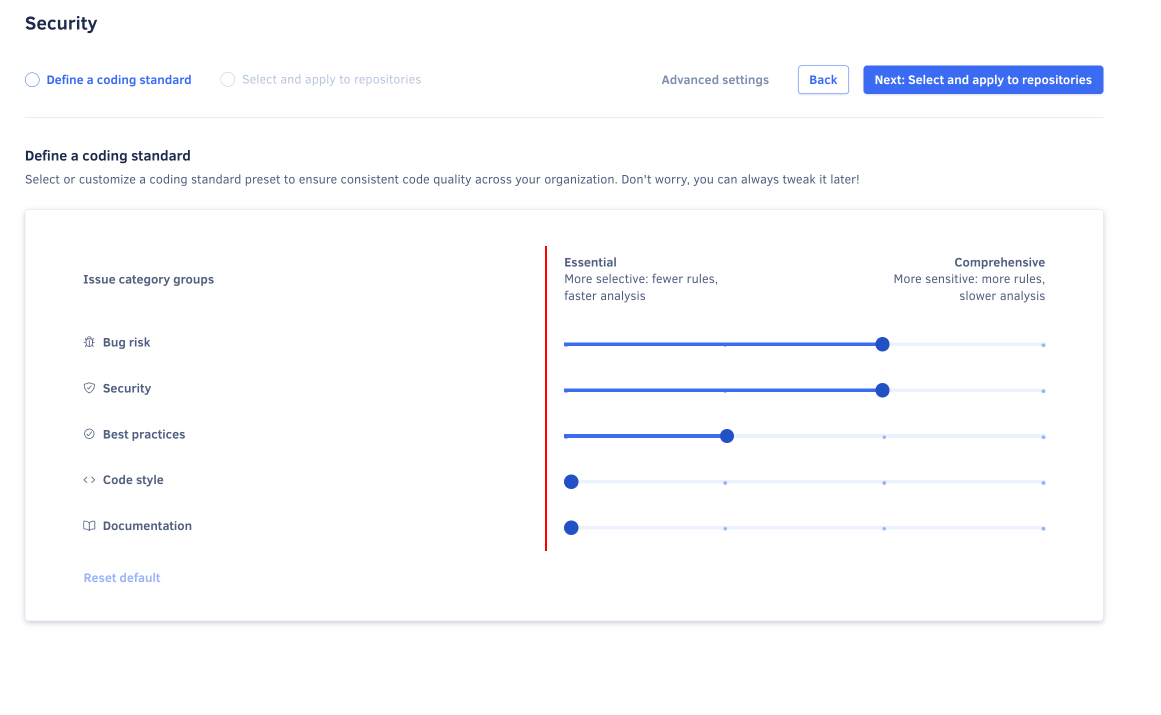
-
Click Next: Select and apply to repositories.
-
Select existing repositories that should follow the new coding standard and click Save and apply standard.
Codacy will start using the new coding standard on the next analysis of each selected repository.
Note
A repository can follow one coding standard at a time. Assigning a coding standard to a repository unassigns any previously assigned coding standard.
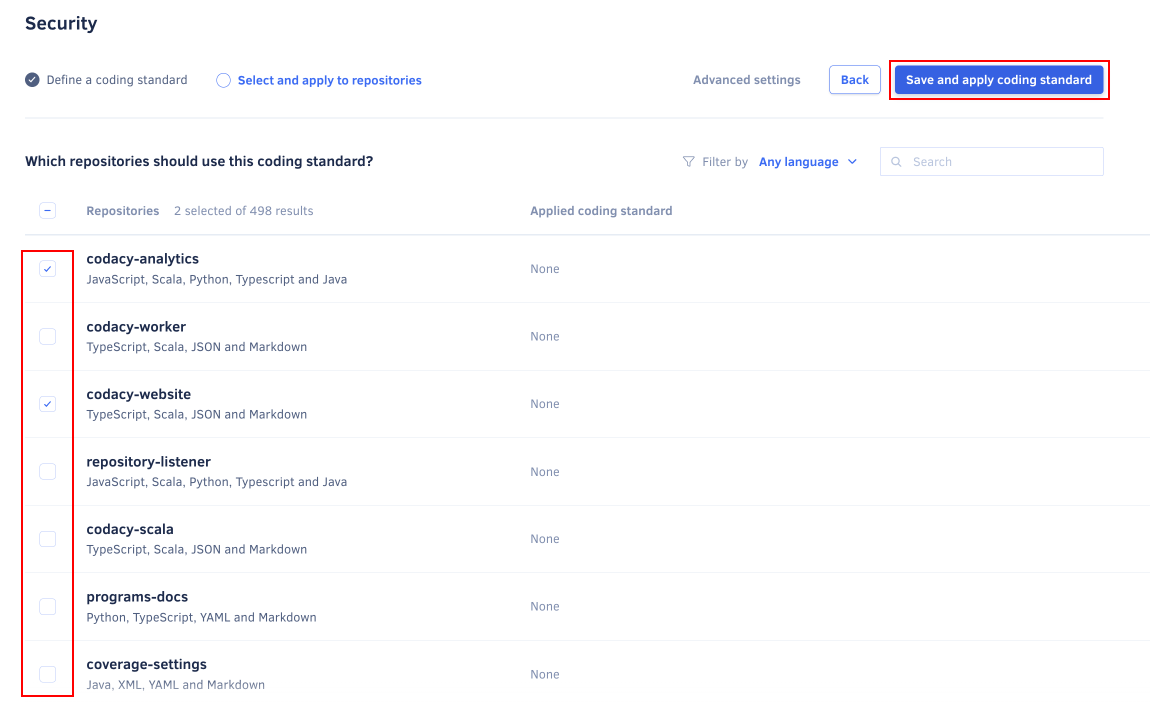
Configuring a coding standard using advanced settings#
If you need more control when creating a new coding standard, use the advanced settings to more precisely define the tools and code patterns that the coding standard should use. You can access the advanced settings from the creation wizard by clicking Advanced settings on the group sensitivity step.
When editing an existing coding standard, the advanced settings are the default view.
To configure a coding standard using advanced settings:
-
Select the programming languages that the new coding standard should cover.
Important
The coding standard will only control tools that can analyze one or more of the languages selected in this step.
If a language is omitted in this step, Codacy uses repository-level tool configurations if present or global Codacy defaults otherwise, and may analyze the omitted language. To prevent this:
-
In this step select all languages, so that the coding standard controls all tools.
-
In the next step, explicitly disable the tools that you don't want to use.

-
-
Click Next: Tools and patterns.
-
Configure the tools and patterns of the coding standard:
- Toggle the tools to run when Codacy analyzes your code.
- For each enabled tool, configure the code patterns to use.
Tip
- Use the filters to find the relevant tools and code patterns. The recommended configurations are manually curated by Codacy or based on tool defaults and are marked with the icon
 .
. - To toggle multiple code patterns at once, click the checkbox of the first pattern and Shift+click the checkbox of the last pattern in a range.
- To toggle all the code patterns visible on the list, click the checkbox on the header of the code patterns list. If there are more code patterns to load on the list, you can click the link Enable/Disable all <N> patterns to toggle all patterns matching the current filters.
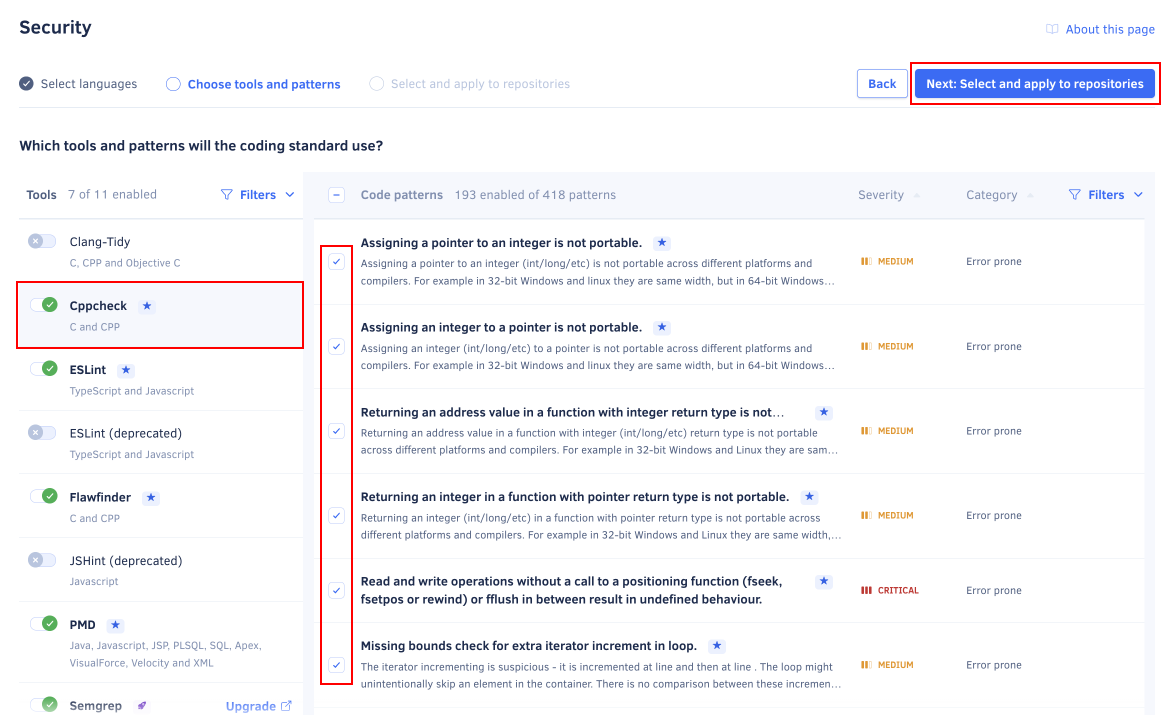
-
Proceed with the remaining wizard steps to finish creating or editing your coding standard.
Defining a default coding standard#
For ease of management, you can define a default coding standard that automatically applies to new repositories. In the absence of a default coding standard, Codacy applies global defaults to all new repositories.
Note
When Codacy introduces new tools, those are automatically added to the global Codacy defaults but need to be manually added to the default coding standard.
You can set a new coding standard as default when creating one.
To set an existing coding standard as default:
-
Open your organization Policies page, tab Coding standards.
-
Toggle Make default on the relevant coding standard card.
Note
Only one coding standard at a time can be the default coding standard.
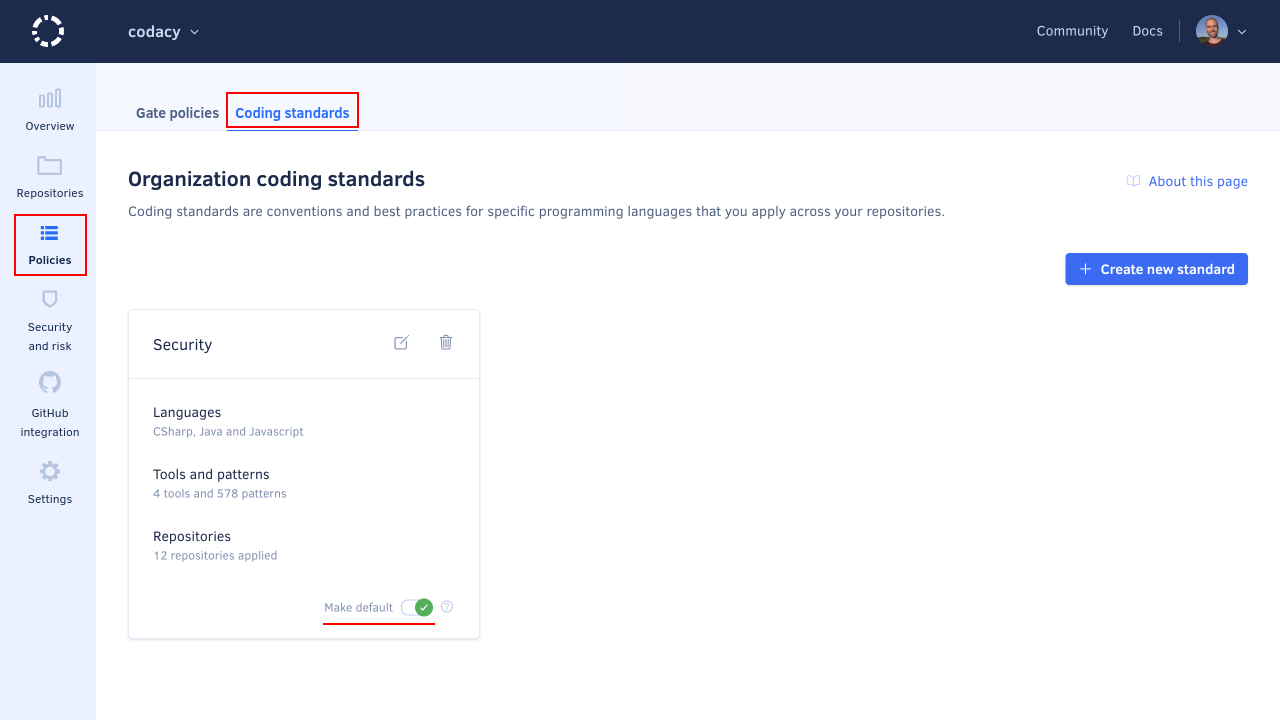
Editing a coding standard#
Note
Any edits to the configurations of a coding standard are automatically applied from the next analysis of each associated repository. However, any edit to the configurations of an associated repository unassigns the coding standard from that repository.
To edit an existing coding standard or change the repositories that follow that coding standard:
-
Open your organization Policies page, tab Coding standards.
-
Click the edit icon on the coding standard card.
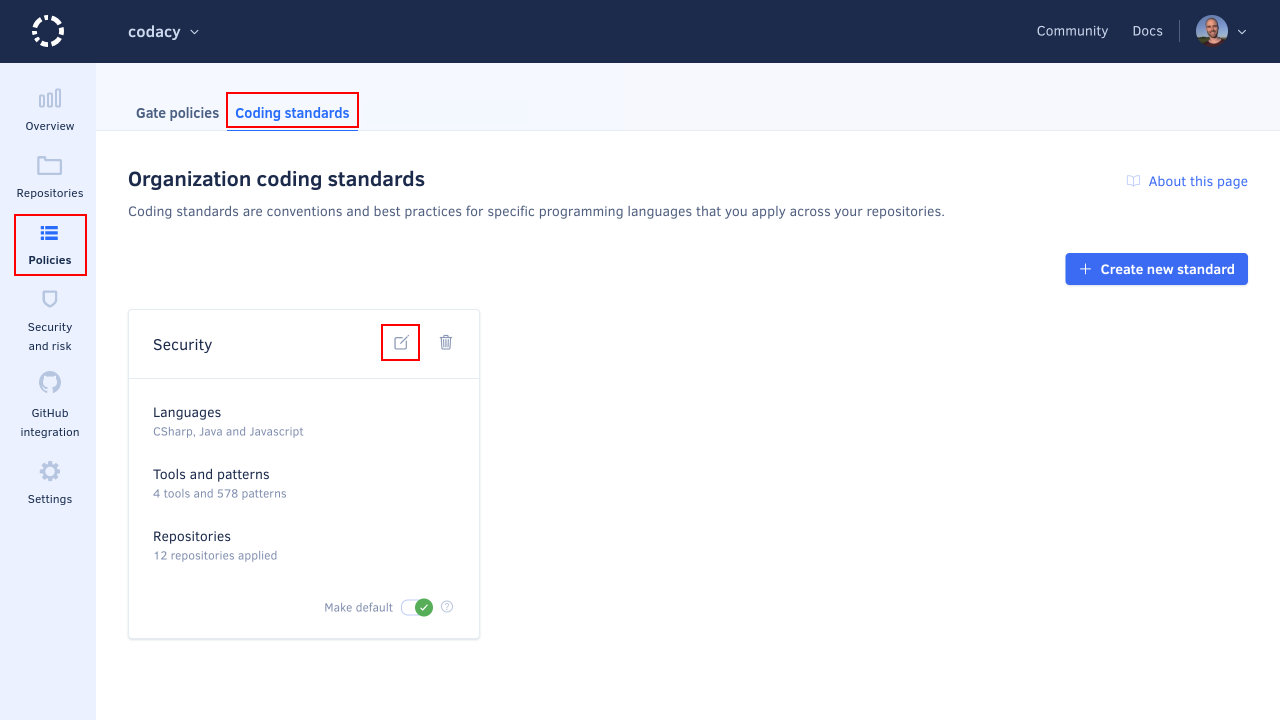
-
Edit the current coding standard configurations and click the button Next to advance to the following configuration pages:
-
Select languages: the programming languages that the coding standard applies to.
On this page, you can rename the coding standard by clicking the edit icon next to the name of the coding standard.

-
Choose tools and patterns: the tool and code pattern configurations of the coding standard.
- Select and apply to repositories: the repositories that follow the coding standard.
-
-
Click the button Save and apply standard on the repository selection page to save your changes to the coding standard.
Codacy will start using the updated coding standard on the next analysis of each selected repository.
Note
If you stop applying a coding standard to a repository, Codacy restores the previous code pattern configurations of that repository, but keeps the tool activation status defined by the coding standard.
Deleting a coding standard#
To delete a coding standard:
-
Open your organization Policies page, tab Coding standards.
-
Click the trash can icon on the coding standard card and confirm.
Note
If you delete a coding standard, Codacy restores the previous code pattern configurations of any repositories following the coding standard, but keeps the tool activation status defined by the coding standard.

Using a coding standard alongside tool configuration files#
When using a tool configuration file alongside a coding standard, the configuration file controls the code patterns, while the coding standard controls whether the tool is enabled or disabled.
See also#
- Configuring code patterns on each repository
- How to implement Google JavaScript style guide with Codacy
Share your feedback 📢
Did this page help you?
Thanks for the feedback! Is there anything else you'd like to tell us about this page?
255 characters left
We're sorry to hear that. Please let us know what we can improve:
255 characters left
Alternatively, you can create a more detailed issue on our GitHub repository.
Thanks for helping improve the Codacy documentation.
Edit this page on GitHub if you notice something wrong or missing.
If you have a question or need help please contact support@codacy.com.